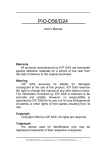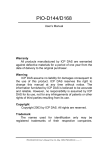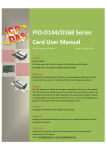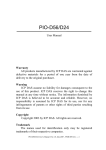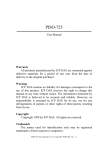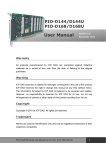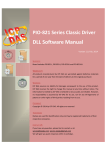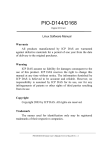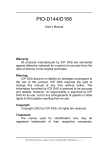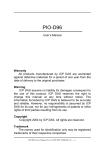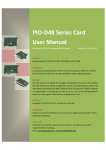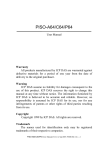Download PIO-DIO Series Classic Driver DLL Software Manual
Transcript
PIO-DIO Series Classic Driver DLL Software Manual Version 1.6, Jun. 2014 SUPPORTS Board includes PIO-D24/D24U/D56/D56U, PIO-D48/D48U/D48SU, PIO-D64/D64U, PIO-D96/D96U/D96SU, PIO-D144/D144U/D144LU, PIO-D168A/D168/D168U, PEX-D24/D56, PEX-D48, PEX-D96S and PEX-D144LS. WARRANTY All products manufactured by ICP DAS are warranted against defective materials for a period of one year from the date of delivery to the original purchaser. WARNING ICP DAS assumes no liability for damages consequent to the use of this product. ICP DAS reserves the right to change this manual at any time without notice. The information furnished by ICP DAS is believed to be accurate and reliable. However, no responsibility is assumed by ICP DAS for its use, nor for any infringements of patents or other rights of third parties resulting from its use. COPYRIGHT Copyright © 2014 by ICP DAS. All rights are reserved. TRADEMARK Names are used for identification only and may be registered trademarks of their respective companies. CONTACT US If you have any question, please feel to contact us at: [email protected]; [email protected] We will give you quick response within 2 workdays. PIO-DIO Series Classic Driver DLL Software Manual TABLE OF CONTENTS 1. 2. INTRODUCTION ................................................................................................................................................... 3 1.1 OBTAINING THE DRIVER INSTALLER PACKAGE ................................................................................................................ 4 1.2 DRIVER INSTALLING PROCEDURE ................................................................................................................................ 5 1.3 PNP DRIVER INSTALLATION ....................................................................................................................................... 8 1.4 UNINSTALLING THE PIO-DIO SERIES CLASSIC DRIVER .................................................................................................. 10 DLL FUNCTION DESCRIPTIONS ............................................................................................................................11 2.1 ERROR CODE TABLE ............................................................................................................................................... 14 2.2 SUB IDS TABLE ..................................................................................................................................................... 15 2.3 TEST FUNCTIONS .................................................................................................................................................. 16 PIODIO_GetDllVersion ............................................................................................................................................... 16 PIODIO_ShortSub ...................................................................................................................................................... 16 PIODIO_FloatSub ....................................................................................................................................................... 17 2.4 DRIVER RELATIVE FUNCTIONS.................................................................................................................................. 18 PIODIO_GetDriverVersion .......................................................................................................................................... 18 PIODIO_DriverInit ...................................................................................................................................................... 18 PIODIO_SearchCard ................................................................................................................................................... 19 PIODIO_GetConfigAddressSpace ............................................................................................................................... 20 PIODIO_DriverClose ................................................................................................................................................... 21 PIODIO_ActiveBoard ................................................................................................................................................. 22 PIODIO_WhichBoardActive ....................................................................................................................................... 22 2.5 DIGITAL I/O FUNCTIONS ........................................................................................................................................ 23 PIODIO_OutputByte................................................................................................................................................... 23 PIODIO_InputByte ..................................................................................................................................................... 23 PIODIO_OutputWord ................................................................................................................................................. 24 PIODIO_InputWord .................................................................................................................................................... 24 2.6 INTERRUPT FUNCTIONS .......................................................................................................................................... 25 PIODIO_IntResetCount .............................................................................................................................................. 25 PIODIO_IntGetCount ................................................................................................................................................. 25 PIODIO_IntInstall ....................................................................................................................................................... 26 PIODIO_IntRemove .................................................................................................................................................... 27 Architecture of Interrupt mode.................................................................................................................................. 28 2.7 PIO-D48 INTERRUPT FUNCTIONS ............................................................................................................................ 30 PIOD48_IntGetCount ................................................................................................................................................. 30 User Manual, Ver. 1.6, Jun. 2014, Page: 1 PIO-DIO Series Classic Driver DLL Software Manual PIOD48_IntInstall ...................................................................................................................................................... 31 PIOD48_IntGetActiveFlag .......................................................................................................................................... 33 PIOD48_IntRemove ................................................................................................................................................... 34 2.8 PIO-D48 COUNTER FUNCTIONS .............................................................................................................................. 35 PIOD48_SetCounter ................................................................................................................................................... 35 PIOD48_ReadCounter ................................................................................................................................................ 36 PIOD48_SetCounterA ................................................................................................................................................ 37 PIOD48_ReadCounterA ............................................................................................................................................. 38 2.9 PIO-D48 FREQUENCY FUNCTIONS ........................................................................................................................... 39 PIOD48_Freq ............................................................................................................................................................. 39 PIOD48_FreqA ........................................................................................................................................................... 40 2.10 PIO-D64 COUNTER FUNCTIONS .............................................................................................................................. 41 PIOD64_SetCounter ................................................................................................................................................... 41 PIOD64_ReadCounter ................................................................................................................................................ 42 PIOD64_SetCounterA ................................................................................................................................................ 43 PIOD64_ReadCounterA ............................................................................................................................................. 44 3. DOS LIB FUNCTION .............................................................................................................................................46 3.1 ERROR CODE TABLE ....................................................................................................................................................... 46 PIO_DriverInit ............................................................................................................................................................ 47 PIO_GetDriverVersion ................................................................................................................................................ 48 PIO_GetConfigAddressSpace ..................................................................................................................................... 48 ShowPIOPISO ............................................................................................................................................................. 50 4. DEMO PROGRAMS .............................................................................................................................................51 4.1 FOR MICROSOFT WINDOWS ................................................................................................................................... 51 4.2 FOR DOS ............................................................................................................................................................ 54 5. PROGRAMS ARCHITECTURE ................................................................................................................................57 6. PROBLEMS REPORT ............................................................................................................................................58 User Manual, Ver. 1.6, Jun. 2014, Page: 2 PIO-DIO Series Classic Driver DLL Software Manual 1. Introduction The software is a collection of digital I/O subroutines for PIO-DIO series card add-on cards for Windows 95/98/NT, Windows 2000 and 32-bit Windows XP/2003/Vista/7/8 applications. The application structure is presented in the following diagram. The subroutines in PIODIO.DLL are easy understanding as its name standing for. It provides powerful, easy-to-use subroutine for developing your data acquisition application. Your program can call these DLL functions by VB, VC, Delphi, BCB, VB.NET 2005 and C#.NET 2005 easily. To speed-up your developing process, some demonstration source program are provided. PIO-DIO Series VB6, VC6, BCB, Delphi, Classic Driver DLL VB.NET, C#.NET… etc. User mode Windows 95/98/NT/2000 Kernel mode 32-bit Windows XP/2003/Vista/7/8 ICP DAS PIO-DIO Series Board Includes PIO-D24/D24U/D56/D56U, PIO-D48/D48U/D48SU, PIO-D64/D64U, PIO-D96/D96U/D96SU, PIO-D144/D144U/D144LU, PIO-D168A/D168/D168U, PEX-D24/D56, PEX-D48, PEX-D96S and PEX-D144LS. User Manual, Ver. 1.6, Jun. 2014, Page: 3 PIO-DIO Series Classic Driver DLL Software Manual 1.1 Obtaining the Driver Installer Package PIO-DIO series card can be used on Linux and Windows 95/98/NT/2000 and 32-bit XP/2003/Vista/7/8 based systems, and the drivers are fully Plug & Play (PnP) compliant for easy installation. The driver installer package for the PIO-DIO series can be found on the supplied CD-ROM, or can be obtained from the ICP DAS FTP web site. The location and addresses are indicated in the table below: CD:\\ NAPDOS\PCI\PIO-DIO\DLL_OCX\ ftp://ftp.icpdas.com/pub/cd/iocard/pci/napdos/pci/pio-dio/dll_ocx/ http://ftp.icpdas.com/pub/cd/iocard/pci/napdos/pci/pio-dio/dll_ocx/ Install the appropriate driver for your operating system, as follows: Name OS For Windows 95, Windows 98, Windows NT, Windows 2000, 32-bit PIO-DIO_Win_xxx.exe Windows XP, 32-bit Windows 2003, 32-bit Windows Vista, 32-bit Windows 7 and 32-bit Windows 8 . For Linux Kernel 2.4.x, 2.6.x and 3.12.x. For detail information about Linux software installation, refer to Ixpio.tar.gz Linux software manual, The download addresses are show below: http://www.icpdas.com/download/pci/linux/ User Manual, Ver. 1.6, Jun. 2014, Page: 4 PIO-DIO Series Classic Driver DLL Software Manual 1.2 Driver Installing Procedure Before the driver installation, you must complete the hardware installation. For detailed information about the hardware installation, please refer to appropriate hardware user manual for your PIO-DIO series card. The hardware user manual is contained in: CD:\NAPDOS\PCI\PIO-DIO \Manual\ http://ftp.icpdas.com/pub/cd/iocard/pci/napdos/pci/pio-dio/manual/ To install the PIO-DIO series classic drivers, follow the procedure described below: Step 1: Double-Click “PIO-DIO_Win_xxxx.exe” to install driver. Step 2: Click the “Next>” button to start the installation on the “Setup – PIO_DIO_Win” window. User Manual, Ver. 1.6, Jun. 2014, Page: 5 PIO-DIO Series Classic Driver DLL Software Manual Step 3: Click the “Next>” button to install the driver into the default folder. Step 4: Click the “Install” button to continue. User Manual, Ver. 1.6, Jun. 2014, Page: 6 PIO-DIO Series Classic Driver DLL Software Manual Step 5: Selection“Yes, restart computer now”and then click the “Finish” button. User Manual, Ver. 1.6, Jun. 2014, Page: 7 PIO-DIO Series Classic Driver DLL Software Manual 1.3 PnP Driver Installation Step 1: The system should find the new card and then continue to finish the Plug&Play steps. Note: Some operating system (such as Windows Vista/7) will find the new card and make it work automatically, so the Step2 to Step4 will be skipped. Step 2: Select “Install the software automatically [Recommended]” and click the “Next>” button. User Manual, Ver. 1.6, Jun. 2014, Page: 8 PIO-DIO Series Classic Driver DLL Software Manual Step 3: Click the “Finish” button. Step 4: Windows pops up “Found New Hardware” dialog box again. User Manual, Ver. 1.6, Jun. 2014, Page: 9 PIO-DIO Series Classic Driver DLL Software Manual 1.4 Uninstalling the PIO-DIO Series Classic Driver The ICP DAS PIO-DIO series classic driver includes an uninstallation utility that allows you remove the software from your computer. To uninstall the software, follow the procedure described below: Step 1: Double clock the unins000.exe uninstaller application, which can be found in the following folder: C:\DAQPro\PIO-DIO. Step 2: A dialog box will be displayed asking you to confirm that you want to remove the utility program. Click the “Yes” button to continue. Step 3: The “Remove Shared File?” dialog box will then be displayed to confirm whether you want to remove the share files. Click the “Yes to All” button to continue. Step 4: After the uninstallation process is complete, a dialog box will be displayed to you that the driver was successfully removed. Click the “OK” button to finish the uninstallation process. User Manual, Ver. 1.6, Jun. 2014, Page: 10 PIO-DIO Series Classic Driver DLL Software Manual 2. DLL Function Descriptions All of the functions provided for PIO-DIO series card are listed below in Tables 2-1 to 2-4. This list of functions is expanded on in the text that follows. However, in order to make a clear and simplified description of the functions, the attributes of the input and output parameters for every function is indicated as [input] and [output] respectively, as shown in following table. Furthermore, the error code of all functions supported by PIO-DIO series card is also listed in Section 2-1. Keyword Parameter must be set by the user before Data/value from this parameter is calling the function retrieved after calling the function [Input] Yes No [Output] No Yes [Input, Output] Yes Yes Note: All of the parameters need to be allocated spaces by the user. Table2-1: Test Functions Table Section Function Definition 2.3 Test Functions WORD PIODIO_GetDllVersion(void); short PIODIO_ShortSub(shor nA, short nB); float PIODIO_FloatSub(float fA, float fB); Table2-2: Driver Relative Functions Table Section Function Definition 2.4 Driver Relative Functions WORD PIODIO_GetDriverVersion(WORD *wDriverVersion); WORD PIODIO_DriverInit(void); WORD PIODIO_SearchCard(WORD *wBoards, DWORDn dwPIOCardID); WORD PIODIO_GetConfigAddressSpace(WORD wBoardNo, DWORD *wAddrBase, WORD *wIrqNo, WORD *wSubVendor, WORD *wSubDevice, WORD *wSubAux, WORD *wSlotBus, WORD *wSlotDevice); User Manual, Ver. 1.6, Jun. 2014, Page: 11 PIO-DIO Series Classic Driver DLL Software Manual viod PIODIO_DriverClose(void); WORD PIODIO_ActiveBoard(WORD wBoardNo); WORD PIODIO_WhichBoardActive(void); Table2-3: Digital I/O Functions Table Section Function Definition 2.5 Digital I/O Functions void PIODIO_OutputByte(DWORD wPortAddr, WORD bOutputValue); WORD PIODIO_InputByte(DWORD wPortAddr); void PIODIO_OutputWord(DWORD wPortAddress, DWORD wOutData); DWORD PIODIO_InputWord(DWORD wPortAddress); Table2-4: Interrupt Functions Table Section Function Definition 2.6 Interrupt Functions WORD PIODIO_IntResetCount(void); WORD PIODIO_IntGetCount(DWORD *dwIntCount); WORD PIODIO_IntInstall(WORD wBoardNo, HANDLE *hEvent, WORD wInterruptSource, WORD wActiveMode); WORD PIODIO_IntRemove(void); Table2-5: PIO-D48 Interrupt Functions Table Section Function Definition 2.7 PIO-D48 Interrupt Functions WORD PIOD48_IntGetCount(DWORD *dwIntCount); WORD PIOD48_IntInstall(WORD wBoardNo, HANDLE *hEvent, WORD wIrqMask, WORD wActiveMode); WORD PIOD48_IntGetActiveFlag(WORD *bActiveHighFlag, WORD *bActiveLowFlag); WORD PIOD48_IntRemove(void); User Manual, Ver. 1.6, Jun. 2014, Page: 12 PIO-DIO Series Classic Driver DLL Software Manual Table2-6: PIO-D48 Counter Functions Table Section Function Definition 2.8 PIO-D48 Counter Functions void PIOD48_SetCounter(DWORD dwBase, WORD wCounterNo, WORD bCounterMode, DWORD wCounterValue); DWORD PIOD48_ReadCounter(DWORD dwBase, WORD wCounterNo, WORD bCounterMode); void PIOD48_SetCounterA(WORD wCounterNo, WORD bCounterMode, DWORD wCounterValue); DWORD PIOD48_ReadCounterA(WORD wCounterNo, WORD bCounterMode); Table2-7: PIO-D48 Frequency Functions Table Section Function Definition 2.9 PIO-D48 Frequency Functions DWORD PIOD48_Freq(DWORD dwBase); DWORD PIOD48_FreqA(); Table2-8: PIO-D64 Counter Functions Table Section Function Definition 2.10 PIO-D64 Counter Functions void PIOD64_SetCounter(DWORD dwBase, WORD wCounterNo, WORD bCounterMode, DWORD wCounterValue); DWORD PIOD64_ReadCounter(DWORD dwBase, WORD wCounterNo, WORD bCounterMode); void PIOD64_SetCounterA(WORD wCounterNo, WORD bCounterMode, DWORD wCounterValue); DWORD PIOD64_ReadCounterA(WORD wCounterNo, WORD bCounterMode); User Manual, Ver. 1.6, Jun. 2014, Page: 13 PIO-DIO Series Classic Driver DLL Software Manual 2.1 Error Code Table For the most errors, it is recommended to check: 1. Does the device driver installs successful? 2. Does the card have plugged? 3. Does the card conflicts with other device? 4. Close other applications to free the system resources. 5. Try to use another slot to plug the card. 6. Restart your system to try again. Error Code Error ID Error String 0 1 PIODIO_NoError PIODIO_DriverOpenError 2 PIODIO_DriverNoOpen 3 PIODIO_GetDriverVersionError OK (No Error) Device driver can’t be opened The PIODIO_DriverInit() function must be called first Get driver version error 4 5 6 7 8 9 PIODIO_InstallIrqError PIODIO_ClearIntCountError PIODIO_GetIntCountError PIODIO_RegisterApcError PIODIO_RemoveIrqError PIODIO_FindBoardError 10 PIODIO_ExceedBoardNumber 11 PIODIO_ResetError Install IRQ error Clear counter value error Get interrupt counter error Get register APC error Remove IRQ error Cannot find board The board number exceeds the maximum board number (7). Can’t reset the interrupt count 12 13 14 15 PIODIO_IrqMaskError PIODIO_ActiveModeError PIODIO_GetActiveFlagError PIODIO_ActiveFlagEndOfQueue Irq-Mask is 1,2,4,8 or 1 to 0xF Active Mode is 1,2 or 1 to 3 Can’t get the interrupt active flag The flag queue is empty User Manual, Ver. 1.6, Jun. 2014, Page: 14 PIO-DIO Series Classic Driver DLL Software Manual 2.2 Sub IDs Table PIO-DIO Series Sub_Vendor ID Sub_Device ID Sub_AUX ID PIO-D168 PIO-D168A 0x9880 0x80 0x01 0x01 0x50 0x50 PIO-D168U PIO-D144 PIO-D144 (Rev 4.0 or above) PIO-D144U PIO-D144LU PEX-D144LS PIO-D96 PIO-D96 (Rev 4.0 or above) PIO-D96U 0x9880 0x80 0x5C80 0x1C80 0x1C80 0x1C80 0x80 0x5880 0x5880 0x01 0x01 0x01 0x01 0x01 0x01 0x01 0x01 0x01 0x50 0x00 0x00 0x00 0x00 0x00 0x10 0x10 0x10 PIO-D96SU PEX-D96S PIO-D64 PIO-D64 (Rev 2.0 or above) PIO-D64U PIO-D56 PIO-D56 (Rev 5.0 or above) PIO-D56U PEX-D56 0x1880 0x1880 0x80 0x4080 0x4080 0x80 0x8080, 0xC080 0x8080, 0xC080 0x8080, 0xC080 0x01 0x01 0x01 0x01 0x01 0x01 0x01 0x01 0x01 0x10 0x10 0x20 0x20 0x20 0x40 0x40 0x40 0x40 PIO-D48 PIO-D48U PIO-D48SU PEX-D48 PIO-D24 PIO-D24 (Rev 5.0 or above) PIO-D24U PEX-D24 0x80 0x0080 0x0080 0x0080 0x80 0x8080, 0xC080 0x8080, 0xC080 0x8080, 0xC080 0x01 0x01 0x01 0x01 0x01 0x01 0x01 0x01 0x40 0x40 0x40 0x30 0x40 0x40 0x40 0x40 User Manual, Ver. 1.6, Jun. 2014, Page: 15 PIO-DIO Series Classic Driver DLL Software Manual 2.3 Test Functions PIODIO_GetDllVersion This function is used to retrieve the version number of the PIODIO.DLL. Syntax: WORD PIODIO_GetDllVersion(void); Parameters: None Returns: DLL version information. For example: If 200(hex) value is return, it means driver version is 2.00. PIODIO_ShortSub This function is used to perform the subtraction (as nA - nB in short data type), and is provided for testing DLL linkage purposes. Syntax: short PIODIO_ShortSub(short nA, short nB); Parameters: nA [Input] 2 bytes short data type value nB [Input] 2 bytes short data type value Returns: The value of nA - nB User Manual, Ver. 1.6, Jun. 2014, Page: 16 PIO-DIO Series Classic Driver DLL Software Manual PIODIO_FloatSub This function is used to perform the subtraction (as fA - fB in float data type), and is provided for testing DLL linkage purpose. Syntax: float PIODIO_FloatSub(float fA, float fB); Parameters: fA [Input] 4 bytes floating point value fB [Input] 4 bytes floating point value Returns: The value of fA - fB User Manual, Ver. 1.6, Jun. 2014, Page: 17 PIO-DIO Series Classic Driver DLL Software Manual 2.4 Driver Relative Functions PIODIO_GetDriverVersion This function is used to read the version number information from the PIODIO driver. Syntax: WORD PIODIO_GetDriverVersion(WORD *wDriverVersion); Parameters: wDriverVersion [Output] wDriverVersion address Returns: Refer to “Section 2.1 Error Code Table” PIODIO_DriverInit This function is used to open the PIODIO driver and allocate the computer resource for the device. This function must be called once before applying other PIODIO functions. Syntax: WORD PIODIO_DriverInit(); Parameters: None Returns: Refer to “Section 2.1 Error Code Table” User Manual, Ver. 1.6, Jun. 2014, Page: 18 PIO-DIO Series Classic Driver DLL Software Manual PIODIO_SearchCard This function can be used to search for the installed card and determine total number of boards. This function must be called once before applying other PIODIO functions. Syntax: WORD PIODIO_SearchCard(WORD *wBoards, DWORDn dwPIOCardID); Parameters: wBoardNo [Output] Determine the total number of boards. DwPIOCardID [Input] Sub IDs of the PIODIO card. Refer to Section 2.2 Sub IDs Table for more details. Note: Different versions of the PIO-DIO series cards may have different Sub IDs. This function will determine the total number of PIO-DIO series cards including all versions; no matter what version Sub ID is input. For example: wRtn=PIODIO_SearchCard(&wBoards, 0x800100); Will determine the total number of PIO-D144 cards installed in the PC regardless of version. Returns: Refer to “Section 2.1 Error Code Table” User Manual, Ver. 1.6, Jun. 2014, Page: 19 PIO-DIO Series Classic Driver DLL Software Manual PIODIO_GetConfigAddressSpace This function is used to obtain the I/O address and other information for the PIO-DIO series cards. Syntax: WORD PIODIO_GetConfigAddressSpace (WORD wBoardNo, DWORD *wAddrBase, WORD *wIrqNo, WORD *wSubVendor, WORD *wSubDevice, WORD *wSubAux, WORD *wSlotBus, WORd *wSlotDevice ); Parameters: wBoardNo [Input] PIO-DIO series card number. wAddrBase [Output] The bases address of PIO-DIO series cards. Only the low WORD is valid. wIrqNo [Output] The IRQ number that is being used by the PISO-DIO series cards using. wSubVendor [Output] Sub Vendor ID. wSubDevice [Output] Sub Device ID. wSubAux [Output] Sub Aux ID. User Manual, Ver. 1.6, Jun. 2014, Page: 20 PIO-DIO Series Classic Driver DLL Software Manual wSlotBus [Output] Slot Bus number. wSlotDevice [Output] Sub Device ID. Returns: Refer to “Section 2.1 Error Code Table” PIODIO_DriverClose This function is used to close the PIODIO Driver and release the device resources from the computer. This function must be called once before exiting the user's application. Syntax: void PIODIO_DriverClose(); Parameters: None Returns: None User Manual, Ver. 1.6, Jun. 2014, Page: 21 PIO-DIO Series Classic Driver DLL Software Manual PIODIO_ActiveBoard This function is used to active one of the PIO-DIO boards installed in the system. This function must call once before the digital input, digital output and interrupt functions are called. Syntax: void PIODIO_ActiveBoard(WORD wBoardNo); Parameters: wBoardNo [Input] The board numbers to active. Returns: Refer to “Section 2.1 Error Code Table” PIODIO_WhichBoardActive This function is used to return the board number of the active board. Syntax: WORD PIODIO_WhichBoardActive(void); Parameters: None Returns: Return the board number of the active board. User Manual, Ver. 1.6, Jun. 2014, Page: 22 PIO-DIO Series Classic Driver DLL Software Manual 2.5 Digital I/O Functions PIODIO_OutputByte This function is used to send 8 bits of data to the specified I/O port. Syntax: void PIODIO_OutputByte(DWORD wPortAddr, WORD bOutputVal); Parameters: wPortAddr [Input] I/O port addresses. Refer to the PIODIO_GetConfigAddressSpace() function. Only the low WORD is valid. bOutputVal [Input] 8 bits of data sent to the I/O port. Only the low BYTE is valid. Returns: None PIODIO_InputByte This function is used to read 8 bits of data from the specified I/O port. Syntax: WORD PIODIO_InputByte(DWORD wPortAddr); Parameters: wPortAddr [Input] I/O port addresses. Refer to the PIODIO_GetConfigAddressSpace() function. Only the low WORD is valid. Returns: 16 bits of data where the leading 8 bits are all 0. (Only the low BYTE is valid.) User Manual, Ver. 1.6, Jun. 2014, Page: 23 PIO-DIO Series Classic Driver DLL Software Manual PIODIO_OutputWord This function is used to send 16 bits of data to the specified I/O port. Syntax: void PIODIO_OutputWord(DWORD wPortAddr, WORD wOutputVal); Parameters: wPortAddr [Input] I/O port addresses. Refer to PIODIO_GetConfigAddressSpace() function. Only the low WORD is valid. wOutputVal [Input] 16 bit data sent to the I/O port. Only the low WORD is valid. Returns: None PIODIO_InputWord This function is used to read 16 bits of data from the specified I/O port. Syntax: WORD PIODIO_InputWord(DWORD wPortAddr); Parameters: wPortAddr [Input] I/O port addresses. Refer to PIODIO_GetConfigAddressSpace() function. Only the low WORD is valid. Returns: 16 bits of data. Only the low WORD is valid. User Manual, Ver. 1.6, Jun. 2014, Page: 24 PIO-DIO Series Classic Driver DLL Software Manual 2.6 Interrupt Functions PIODIO_IntResetCount This function is used to clear the counter value of the device driver for the interrupt. Syntax: WORD PIODIO_IntResetCount(void); Parameters: None Returns: Refer to “Section 2.1 Error Code Table” PIODIO_IntGetCount This function is used to read the dwIntCount value defined in the device driver. Syntax: WORD PIODIO_IntGetCount(WORD *dwIntCount); Parameters: *dwIntCount [Output] Address of dwIntCount, which is used of store the value of the interrupt counter. Returns: Refer to “Section 2.1 Error Code Table” User Manual, Ver. 1.6, Jun. 2014, Page: 25 PIO-DIO Series Classic Driver DLL Software Manual PIODIO_IntInstall This function is used to install the IRQ service routine. Syntax: WORD PIODIO_IntInstall(WORD wBoardNo, HANDLE *hEvent, WORD wInterruptSource, WORD wActiveMode); Parameters: wBoardNo [Input] The board to be used. hEvent [Input] Address of an Event handle. The user’s program must call the Windows API function “Create Event()” to create an event object. wInterruptSource [Input] The Interrupt Source to be used. Refer to hardware's manual of PIO-DIO series for the detail information. Model wInterruptSource Description PIO-D48 series 0 1 2 3 0 PC3/PC7 from Port-2 PC3/PC7 from Port-5 Cout0 Cout2 PC0 1 2 3 0 1 2 0 1 2 PC1 PC2 PC3 EXTIRQ EVTIRQ TMRIRQ P2C0 P5C0 P8C0 3 P11C0 PIO-D56/D24 series PIO-D64 series PIO-D96 series User Manual, Ver. 1.6, Jun. 2014, Page: 26 PIO-DIO Series Classic Driver DLL Software Manual Model wInterruptSource Description PIO-D144/D168 series 0 1 2 3 P2C0 P2C1 P2C2 P2C3 wActiveMode [Input] The mode for triggering the interrupt. wActiveMode Description 0 1 PIODIO_ActiveLow PIODIO_ActiveHigh Returns: Refer to “Section 2.1 Error Code Table” PIODIO_IntRemove This function is used to remove the IRQ service routine. Syntax: WORD PIODIO_IntRemove(void); Parameters: None Returns: Refer to “Section 2.1 Error Code Table” User Manual, Ver. 1.6, Jun. 2014, Page: 27 PIO-DIO Series Classic Driver DLL Software Manual Architecture of Interrupt mode Please refer to the following Windows API functions: The following portion description of these functions was copied from MSDN. For the detailed and completely information, please refer to MSDN. CreateEvent( ) The CreateEvent function creates or opens a named or unnamed event object. HANDLE CreateEvent( // pointer to security attributes LPSECURITY_ATTRIBUTES lpEventAttributes, BOOL bManualReset, // flag for manual-reset event BOOL bInitialState, // flag for initial state LPCTSTR lpName // pointer to event-object name ); User Manual, Ver. 1.6, Jun. 2014, Page: 28 PIO-DIO Series Classic Driver DLL Software Manual CreateThread( ) The CreateThread function creates a thread to execute within the virtual address space of the calling process. To create a thread that runs in the virtual address space of another process, use the CreateRemoteThread function. HANDLE CreateThread( // pointer to security attributes LPSECURITY_ATTRIBUTES lpThreadAttributes, DWORD dwStackSize, // initial thread stack size // pointer to thread function LPTHREAD_START_ROUTINE lpStartAddress, LPVOID lpParameter, // argument for new thread DWORD dwCreationFlags, // creation flags LPDWORD lpThreadId // pointer to receive thread ID ); WaitForSingleObject( ) The WaitForSingleObject function returns when one of the following occurs: The specified object is in the signaled state. The time-out interval elapses. To enter an alertable wait state, use the WaitForSingleObjectEx function. To wait for multiple objects, use the WaitForMultipleObjects. DWORD WaitForSingleObject( HANDLE hHandle, DWORD dwMilliseconds ); // handle to object to wait for // time-out interval in milliseconds User Manual, Ver. 1.6, Jun. 2014, Page: 29 PIO-DIO Series Classic Driver DLL Software Manual 2.7 PIO-D48 Interrupt Functions The following PIOD48_XXX series function is designed for PIO-D48 series card only. They cannot be used with other cards. The most different between the PIO-DIO and PIO-D48 interrupt functions is the PIO-DIO supports only one interrupt-source at a time and the PIO-D48 supports 4 interrupt-source at a time. PIOD48_IntGetCount This subroutine will read the Interrupt-Counter value in the device driver. The Interrupt-Counter will be increased (in the ISR) when the interrupt is triggered. When the interrupt setting to Active-High only or Active-Low only, some of the interrupt signal will be ignored and the Interrupt-Counter will not increase. Syntax: WORD PIOD48_IntGetCount(DWORD *dwIntCount); Parameters: *dwIntCount [Output] Address of dwIntCount, which is used of store the value of the interrupt counter. Returns: Refer to “Section 2.1 Error Code Table” User Manual, Ver. 1.6, Jun. 2014, Page: 30 PIO-DIO Series Classic Driver DLL Software Manual PIOD48_IntInstall This subroutine will install the IRQ service routine. This function supports multiple interrupt-source and the Active-Mode can setting to "Active-Low only", "Active-High only" and "Active-Low or Active-High". Syntax: WORD PIOD48_IntInstall(WORD wBoardNo, HANDLE *hEvent, WORD wIrqMask, WORD wActiveMode); Parameters: wBoardNo [Input] The board to be used. hEvent [Input] Address of an Event handle. The user’s program must call the Windows API function “Create Event()” to create an event object. wIrqMask [Input] The IRQ Mask to be used. Refer to hardware's manual of PIO-D48 series for the detail information. wIrqMask Description 1 2 4 8 NT_CHAN_0: PC3/PC7 from Port-2 INT_CHAN_1: PC3/PC7 from Port-5 INT_CHAN_2: Cout0 INT_CHAN_3: Cout2 This function supports 4 interrupt-source at a time, thus users can use multiple interrupt-source like 1 +2 +4 +8. User Manual, Ver. 1.6, Jun. 2014, Page: 31 PIO-DIO Series Classic Driver DLL Software Manual wActiveMode [Input] When the ISR will service the interrupt ? wActiveMode Description 1 PIOD48_ActiveLow The interrupt is occurred Interrupt-Source status is low. PIOD48_ActiveHigh 2 The interrupt is occurred Interrupt-Source status is high. when the when the This can be 1 (Active-High), 2(Active-Low) or 1 + 2 (Both of the High and Low will active the interrupt). Returns: Refer to “Section 2.1 Error Code Table” User Manual, Ver. 1.6, Jun. 2014, Page: 32 PIO-DIO Series Classic Driver DLL Software Manual PIOD48_IntGetActiveFlag This subroutine will read the Active-High and Active-Low flag from the device driver's memory queues (First-in-First-out, Buffer Size: 2000 flags for High/Low). The Active-Flag is used to records the Active-State-change of interrupt-source when the interrupt occurred. The Active-High-Flag records which interrupt-source changed to high state and the Active-Low-Flag records which interrupt-source changed to low state. Users can uses these flags to indicate which interrupt-source has changed. If the Active-Mode is set to Active-Low(/Active-High) only and the state for the Active-Low(/Active-High) is equal to zero, then the ISR will not increased the interrupt-counter, and the Active-Flag for High and Low will not recorded. If users have not calling this function to retrieve the flags from device driver's memory queues, these queues will stop record the flags (lost data) while the buffer is full. But the interrupt-counter will still counting while the ISR services the interrupt. Syntax: WORD PIOD48_IntGetActiveFlag(WORD *bActiveHighFlag, WORD *bActiveLowFlag); Parameters: bActiveHighFlag [Output] Returns a flag that indicates which interrupt-source changed to High-State. bActiveLowFlag [Output] Returns a flag that indicates which interrupt-source changed to Low-State. Returns: Refer to “Section 2.1 Error Code Table” User Manual, Ver. 1.6, Jun. 2014, Page: 33 PIO-DIO Series Classic Driver DLL Software Manual PIOD48_IntRemove This function is used to remove the IRQ service routine. Syntax: WORD PIOD48_IntRemove(void); Parameters: None Returns: Refer to “Section 2.1 Error Code Table” User Manual, Ver. 1.6, Jun. 2014, Page: 34 PIO-DIO Series Classic Driver DLL Software Manual 2.8 PIO-D48 Counter Functions The following PIOD48_XXX series function is designed for PIO-D48 series card only. PIOD48_SetCounter This subroutine is used to set the 8254 counter's mode and value. Syntax: WORD PIOD48_SetCounter(WORD dwBase, WORD wCounterNo, WORD bCounterMode, DWORD wCounterValue); Parameters: dwBase [Input] I/O port addresses. Refer to the PIODIO_GetConfigAddressSpace() function. Only the low WORD is valid. wCounterNo [Input] The 8254 Counter-Number: 0 to 2. wCounterMode [Input] The 8254 Counter-Mode: 0 to 5. Refer to the hardware’s manual of PIO-D48 series card for details. wCounterValue [Input] The 16 bits value for the timer/counter to count. Only the low WORD is valid. Returns: None User Manual, Ver. 1.6, Jun. 2014, Page: 35 PIO-DIO Series Classic Driver DLL Software Manual PIOD48_ReadCounter This subroutine is used to read the 8254 counter's value. Syntax: WORD PIOD48_ReadCounter(WORD dwBase, WORD wCounterNo, WORD bCounterMode); Parameters: dwBase [Input] I/O port addresses. Refer to the PIODIO_GetConfigAddressSpace() function. Only the low WORD is valid. wCounterNo [Input] The 8254 Counter-Number: 0 to 2. wCounterMode [Input] The 8254 Counter-Mode: 0 to 5. Refer to the hardware’s manual of PIO-D48 series card for details. Returns: Returns the 16 bits counter value. (Only the low WORD is valid.) User Manual, Ver. 1.6, Jun. 2014, Page: 36 PIO-DIO Series Classic Driver DLL Software Manual PIOD48_SetCounterA This subroutine is used to set the 8254 counter's mode and value. Users have to call the PIODIO_ActiveBoard() function before calling this function. Syntax: WORD PIOD48_SetCounterA(WORD wCounterNo, WORD bCounterMode, WORD wCounterValue); Parameters: wCounterNo [Input] The 8254 Counter-Number: 0 to 2. wCounterMode [Input] The 8254 Counter-Mode: 0 to 5. Refer to the hardware’s manual of PIO-D48 series card for details. wCounterValue [Input] The 16 bits value for the counter to count. Only the low WORD is valid. Returns: None User Manual, Ver. 1.6, Jun. 2014, Page: 37 PIO-DIO Series Classic Driver DLL Software Manual PIOD48_ReadCounterA This subroutine is used to read the 8254 counter's value. Users have to call the PIODIO_ActiveBoard() function before calling this function. Syntax: WORD PIOD48_ReadCounterA(WORD wCounterNo, WORD bCounterMode); Parameters: wCounterNo [Input] The 8254 Counter-Number: 0 to 2. wCounterMode [Input] The 8254 Counter-Mode: 0 to 5. Refer to the hardware’s manual of PIO-D48 series card for details. Returns: Returns the 16 bits counter value. (Only the low WORD is valid.) User Manual, Ver. 1.6, Jun. 2014, Page: 38 PIO-DIO Series Classic Driver DLL Software Manual 2.9 PIO-D48 Frequency Functions The following PIOD48_XXX series function is designed for PIO-D48 series card only. PIOD48_Freq This subroutine is used to measurement the signal frequency. Users have to connect the signal(+) with CN1.Pin29, and connect the signal(-) with CN1.Pin19. It will uses the Counter-0 and Counter-1 to measure the frequency, thus users shouldn't use Counter-0 and Counter-1 for other purposes. Syntax: WORD PIOD48_Freq(WORD dwBase); Parameters: dwBase [Input] I/O port addresses. Refer to the PIODIO_GetConfigAddressSpace() function. Only the low WORD is valid. Returns: Return the frequency value. (Only the low WORD is valid.) User Manual, Ver. 1.6, Jun. 2014, Page: 39 PIO-DIO Series Classic Driver DLL Software Manual PIOD48_FreqA Please refer to the description of "PIOD48_Freq()" function. Users have to calling the "PIODIO_ActiveBoard()" function before calling this function. Syntax: WORD PIOD48_FreqA(); Parameters: None Returns: Return the frequency value. (Only the low WORD is valid.) User Manual, Ver. 1.6, Jun. 2014, Page: 40 PIO-DIO Series Classic Driver DLL Software Manual 2.10 PIO-D64 Counter Functions The following PIOD64_XXX series function is designed for PIO-D64 series card only. PIOD64_SetCounter This subroutine is used to set the 8254 counter's mode and value. Syntax: WORD PIOD64_SetCounter(WORD dwBase, WORD wCounterNo, WORD bCounterMode, DWORD wCounterValue); Parameters: dwBase [Input] I/O port addresses. Refer to the PIODIO_GetConfigAddressSpace() function. Only the low WORD is valid. wCounterNo [Input] The 8254 Counter-Number: 0 to 5. (0 to 2: Chip-0, 3 to 5: Chip-1) wCounterMode [Input] The 8254 Counter-Mode: 0 to 5. Refer to the hardware’s manual of PIO-D64 series card for details. wCounterValue [Input] The 16 bits value for the counter to count. Only the low WORD is valid. Returns: None User Manual, Ver. 1.6, Jun. 2014, Page: 41 PIO-DIO Series Classic Driver DLL Software Manual PIOD64_ReadCounter This subroutine is used to read the 8254 counter's value. Syntax: WORD PIOD64_ReadCounter(WORD dwBase, WORD wCounterNo, WORD bCounterMode); Parameters: dwBase [Input] I/O port addresses. Refer to the PIODIO_GetConfigAddressSpace() function. Only the low WORD is valid. wCounterNo [Input] The 8254 Counter-Number: 0 to 5. (0 to 2: Chip-0, 3 to 5: Chip-1) wCounterMode [Input] The 8254 Counter-Mode: 0 to 5. Refer to the hardware’s manual of PIO-D64 series card for details. Returns: Returns the 16 bits counter value. (Only the low WORD is valid.) User Manual, Ver. 1.6, Jun. 2014, Page: 42 PIO-DIO Series Classic Driver DLL Software Manual PIOD64_SetCounterA This subroutine is used to set the 8254 counter's mode and value. Users have to call the PIODIO_ActiveBoard() function before calling this function. Syntax: WORD PIOD64_SetCounterA(WORD wCounterNo, WORD bCounterMode, WORD wCounterValue); Parameters: wCounterNo [Input] The 8254 Counter-Number: 0 to 5. (0 to 2: Chip-0, 3 to 5: Chip-1) wCounterMode [Input] The 8254 Counter-Mode: 0 to 5. Refer to the hardware’s manual of PIO-D64 series card for details. wCounterValue [Input] The 16 bits value for the counter to count. Only the low WORD is valid. Returns: None User Manual, Ver. 1.6, Jun. 2014, Page: 43 PIO-DIO Series Classic Driver DLL Software Manual PIOD64_ReadCounterA This subroutine is used to read the 8254 counter's value. Users have to call the PIODIO_ActiveBoard() function before calling this function. Syntax: WORD PIOD64_ReadCounterA(WORD wCounterNo, WORD bCounterMode); Parameters: wCounterNo [Input] The 8254 Counter-Number: 0 to 5. (0 to 2: Chip-0, 3 to 5: Chip-1) wCounterMode [Input] The 8254 Counter-Mode: 0 to 5. Refer to the hardware’s manual of PIO-D64 series card for details. Returns: Returns the 16 bits counter value. (Only the low WORD is valid.) User Manual, Ver. 1.6, Jun. 2014, Page: 44 PIO-DIO Series Classic Driver DLL Software Manual User Manual, Ver. 1.6, Jun. 2014, Page: 45 PIO-DIO Series Classic Driver DLL Software Manual 3. DOS Lib Function 3.1 Error Code Table Error Code Error ID Error String 0 1 2 3 4 NoError DriverHandleError DriverCallError FindBoardError TimeOut 5 ExceedBoardNumber OK (No Error) Device driver opened error Got the error while calling the drier functions Can’t find the board on the system Timeout Invalidate board number 6 NotFoundBoard (Valid range: 0 to TotalBoard -1 ) Can’t detect the board on the system User Manual, Ver. 1.6, Jun. 2014, Page: 46 PIO-DIO Series Classic Driver DLL Software Manual PIO_DriverInit This function can detect all PIO/PISO series cards in the system. It is implemented based on the PCI Plug & Play mechanism-1. It will find all PIO/PISO series cards installed in this system and save all their resources in the library. Syntax: WORD PIO_DriverInit(WORD *wBoards, WORD wSubVendorID, WORD wSubDeviceID, WORD wSubAuxID); Parameters: wBoards [Output] Number of boards found in the PC. wSubVendorID [Input] SubVendor ID of the PIO/PISO series board. wSubDeviceID [Input] SubDevice ID of the PIO/PISO series board. wSubAuxID [Input] SubAux ID of the PIO/PISO series board. Returns: Refer to “Section 3.1 Error Code Table” User Manual, Ver. 1.6, Jun. 2014, Page: 47 PIO-DIO Series Classic Driver DLL Software Manual PIO_GetDriverVersion This subroutine will obtain the version number of PIO/PISO driver. Syntax: WORD PIO_GetDriverVersion(WORD *wDriverVersion); Parameters: *wDriverVersion [Output] wDriverVersion address. Returns: Refer to “Section 3.1 Error Code Table” PIO_GetConfigAddressSpace The user can use this function to save the resources found on all the PIO/PISO cards installed on the system. Then the application program can control all the functions of PIO/PISO series cards directly. Syntax: WORD PIO_GetConfigAddressSpace(wBoardNo, *wBase, *wIrq, wSubVendor, *wSubDevice, *wSubAux, *wSlotBus, *wSlotDevice); User Manual, Ver. 1.6, Jun. 2014, Page: 48 PIO-DIO Series Classic Driver DLL Software Manual Parameters: wBoardNo [Input] Number of boards found in the PC. *wBase [Output] The base address of the PIO/PISO series board. *wIrq [Output] The IRQ number that the PIO/PISO using. wSubVendor [Output] SubVendor ID of the PIO/PISO series board. *wSubDevice [Output] SubDevice ID of the PIO/PISO series board. *wSubAux [Output] SubAux ID of the PIO/PISO series board. *wSlotBus [Output] Slot Bus number. *wSlotDevice [Output] Slot Device ID Returns: Refer to “Section 3.1 Error Code Table” User Manual, Ver. 1.6, Jun. 2014, Page: 49 PIO-DIO Series Classic Driver DLL Software Manual ShowPIOPISO This function will show a text string for a special Sub_ID. This text string is the same as that defined in PIO.H. Syntax: WORD ShowPIOPISO(wSubVendor, wSubDevice, wSubAux); Parameters: wSubVendor [Input] SubVendor ID of the board wSubDevice [Input] SubDevice ID of the board wSubAux [Input] SubAux ID of the board Returns: Refer to “Section 3.1 Error Code Table” User Manual, Ver. 1.6, Jun. 2014, Page: 50 PIO-DIO Series Classic Driver DLL Software Manual 4. Demo Programs 4.1 For Microsoft Windows ICP DAS PIO-DIO Series Classic Driver DLL contains a set of functions. It can be used in various application programs for PIO-DIO series card. The API functions supports many development environments and programming languages, including Microsoft Visual C++,Visual Basic,Borland Delphi,Borland C Builder++,Microsoft Visual C#.NET,Microsoft Visual VB.NET. The demo programs of Windows OS for the PIO-DIO series can be found on the supplied CD-ROM, or can be obtained from the ICP DAS FTP web site. The location and addresses are indicated in the table below: CD:\NAPDOS\PCI\PIO-DIO\DLL_OCX\Demo\ http://ftp.icpdas.com/pub/cd/iocard/pci/napdos/pci/pio-dio/dll_ocx/demo/ BCB4 for Borland C++ Builder 4 PIODIO.H Header files PIODIO.LIB Linkage library for BCB only Delphi4 for Delphi 4 PIODIO.PAS Declaration files VC6 for Visual C++ 6 PIODIO.H Header files PIODIO.LIB Linkage library for VC only VB6 for Visual Basic 6 PIODIO.BAS Declaration files VB.NET2005 for VB.NET2005 PIODIO.vb Visual Basic Source files CSharp2005 for C#.NET2005 PIODIO.cs Visual C# Source files User Manual, Ver. 1.6, Jun. 2014, Page: 51 PIO-DIO Series Classic Driver DLL Software Manual Select the appropriate demo for your PIO-DIO series card, as follows: Folder The list of demo programs D24 For PIO-D24/D24U, PEX-D24 DIO Demo Int Demo IntAPC demo For PIO-D56/D56U, PEX-D56 DIO_1 Demo D56 DIO_2 Demo Int Demo IntAPC Demo For PIO-D48/D48U/D48SU, PEX-D48 DIO Demo Freq Demo Int Demo Int1APC Demo D48 Int2 Demo Int2APC Demo Int3 Int3APC Demo Int4 Int4APC Demo Read Counter Demo For PIO-D64/D64U D64 D96 DIO Demo Int Demo IntAPC Demo Counter Demo 32bitCounter Demo For PIO-D96/D96U/D96SU, PEX-D96S DIO Demo Int Demo IntAPC Demo User Manual, Ver. 1.6, Jun. 2014, Page: 52 PIO-DIO Series Classic Driver DLL Software Manual D144 D168 For PIO-D144/D144U/D144LU, PEX-D144S DIO Demo DIO2 Demo DO Demo Int Demo IntAPC Demo For PIO-D168/D168A/D168U DIO Demo DIO2 Demo DO Demo Int Demo IntAPC Demo User Manual, Ver. 1.6, Jun. 2014, Page: 53 PIO-DIO Series Classic Driver DLL Software Manual 4.2 For DOS The demo program is contained in: CD:\NAPDOS\PCI\PIO-DIO\DOS\ http://ftp.icpdas.com/pub/cd/iocard/pci/napdos/pci/pio-dio/dos/ \TC\*.* for Turbo C 2.xx or above \MSC\*.* for MSC 5.xx or above \BC\*.* for BC 3.xx or above \TC\LIB\*.* for TC Library \TC\DEMO\*.* for TC demo program \TC\DIAG\*.* for TC diagnostic program \TC\LIB\Large\PIO.H \TC\LIB\Large\TCPIO_L.LIB \TC\LIB\Huge\TCPIO_H.LIB TC Declaration File TC Large Model Library File TC Huge Model Library File \MSC\LIB\Large\PIO.H \MSC\LIB\Large\MSCPIO_L.LIB \MSC\LIB\Huge\MSCPIO_H.LIB \BC\LIB\Large\PIO.H \BC\LIB\Large\BCPIO_L.LIB \BC\LIB\Huge\BCPIO_H.LIB MSC Declaration File MSC Large Model Library File MSC Huge Model Library File BC Declaration File BC Large Model Library File BC Huge Model Library File User Manual, Ver. 1.6, Jun. 2014, Page: 54 PIO-DIO Series Classic Driver DLL Software Manual Select the appropriate demo for your PIO-DIO series card, as follows: Folder The list of demo programs diag For all PISO/DIO series card PIO_PISO.exe For PIO-D24/D24U/D56/D56U, PEX-D24/D56 Demo1: DO demo of CON3 D2456 Demo2: DI/O demo of CON1, CON2 and CON3 Demo3: Count high pulse of PC0 (Initial low & active high) Demo4: Count high pulse of PC0 (Initial high & active low) Demo5: Four Interrupt Source For PIO-D48/D48U/D48SU, PEX-D48 Demo1: DO demo of CN1 and CN2 Demo2: DI demo of CN1 and CN2 D48 Demo3: DI/O demo of CN1 and CN2 Demo4: INT_CHAN_3, timer interrupt Demo5: INT_CHAN_2, 16-bit event counter (no interrupt), init_HIGH & active_LOW signal to PC0 of port-2. Demo6: INT_CHAN_2, 16-bit event counter (no interrupt), init_LOW & active_HIGH signal to PC0 of port-2. Demo7: INT_CHAN_2, 16-bit down-counter (using interrupt), init_HIGH & active_LOW signal to PC3 of port-2. (Note: The PC7 of port_2 is used to enable the interrupt) Demo8: INT_CHAN_0, interrupt demo, init_HIGH & active_LOW signal to PC3 of port-2. (Note: The PC7 of port_2 is don’t case) Demo9: INT_CHAN_0, interrupt demo, init_HIGH & active_LOW signal to PC3 of port-2. (Note: The PC7 of port_2 is used to enable the interrupt) Demo10: INT_CHAN_1, interrupt demo, init_HIGH & active_LOW signal to PC3 of port-5. (Note: The PC7 of port_5 is used to enable the interrupt) Demo11: INT_CHAN_0 & INT_CHAN_1, interrupt demo, init_HIGH & active_LOW signal to PC3 of port-2 (port-5). (Note: The PC7 of port-2(port_5) is don’t care) User Manual, Ver. 1.6, Jun. 2014, Page: 55 PIO-DIO Series Classic Driver DLL Software Manual D64 For PIO-D64/D64U Demo1: DO demo Demo2: DI/O demo Demo3: Use external int. to measure pulse width (high level) Demo4: Use EVTIRQ to count event Demo5: Use TMRIRQ to generate 0.5 Hz squa. Demo6: Use TMRIRQ to generate 0.5 Hz squa. EVTIRQ to count For PIO-D96/D96U/D96SU, PEX-D96S D96 Demo1: DO demo of CN1 Demo2: DI/O demo of CN2 and CN3 Demo3: Count high pulse of P2C0 (initial Low & active High) Demo4: Count high pulse of P2C0 (initial High & active Low) Demo5: Four Interrupt Source For PIO-D144/D144U/D144LU, PEX-D144S Demo1: DO of CN1 Demo2: DO of CN1 to CN6 D144 Demo3: Interrupt of P2C0 (Initial low & active high) Demo4: Interrupt of P2C0 (Initial high & active low) Demo5: 4 Interrupt sources Demo6: DO demo Demo10: Find card number For PIO-D168/D168A/D168U Demo1: DO of CN1 D168 Demo2: DO of the CN1 to CN6 Demo3: Interrupt of P2C0 (Initial low & active high) Demo4: Interrupt of P2C0 (Initial high & active low) Demo5: 4 Interrupt sources Note that all of the hardware control functions need to be provided and processed by user themselves. User Manual, Ver. 1.6, Jun. 2014, Page: 56 PIO-DIO Series Classic Driver DLL Software Manual 5. Programs Architecture Initialize the Device Driver PIODIO_DriverInit() // Enable All DI/DO Ports …. PIODIO_InputByte(….) …………….. ……………… Access/Control the Device . . . PIODIO_OutputByte(….) ……….. Access/Control the Device PIODIO_DriverClose() Close the Device-Driver User’s Application Function Call into DLLs Development Toolkit DLLs Services Call into Kernel-Mode .VXDs、.SYSs (Device Driver) Device Control Hardware Devices User Manual, Ver. 1.6, Jun. 2014, Page: 57 PIO-DIO Series Classic Driver DLL Software Manual 6. Problems Report Technical support is available at no charge as described below. The best way to report problems is to send electronic mail to [email protected] or Service.icpdas@ gmail.com on the Internet. When reporting problems, please include the following information: 1. Is the problem reproducible? If so, how? 2. What kind and version of platform that you using? For example, Windows 98, Windows 2000 or 32-bit Windows XP/2003/Vista/7/8. 3. What kinds of our products that you using? Please see the product’s manual. 4. If a dialog box with an error message was displayed, please include the full test of the dialog box, including the text in the title bar. 5. If the problem involves other programs or hardware devices, what devices or version of the failing programs that you using? 6. Other comments relative to this problem or any suggestions will be welcomed. After we had received your comments, we will take about two business days to test the problems that you said. And then reply as soon as possible to you. Please check that if we had received you comments? And please keeps contact with us. User Manual, Ver. 1.6, Jun. 2014, Page: 58





























































